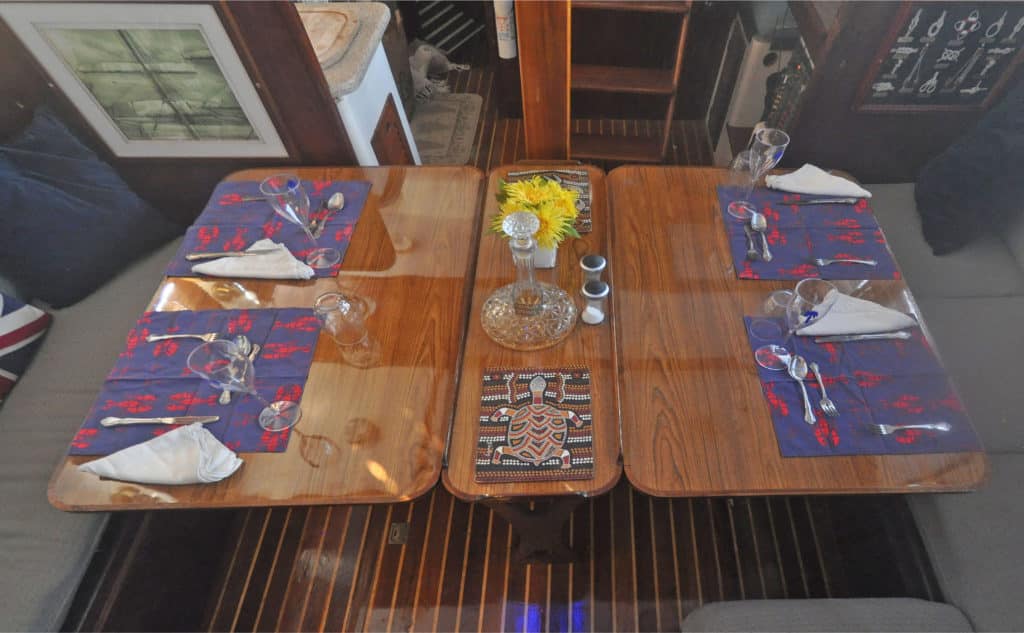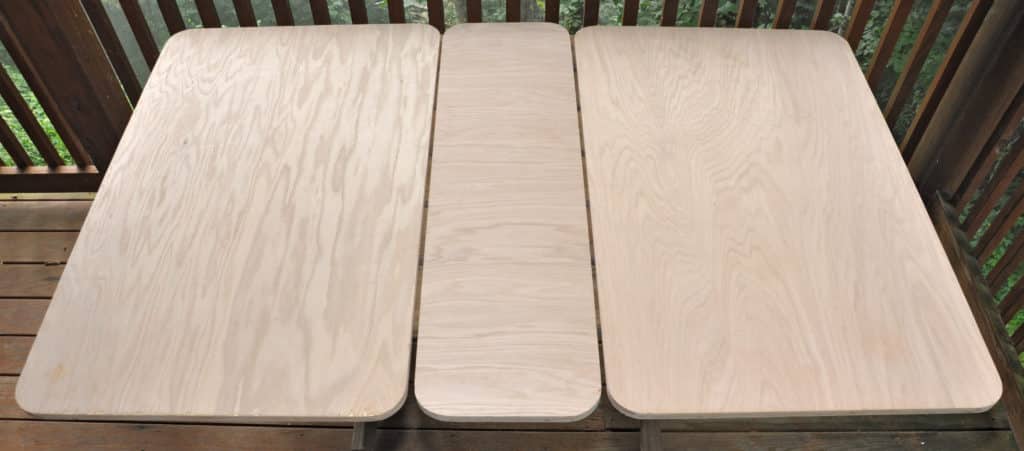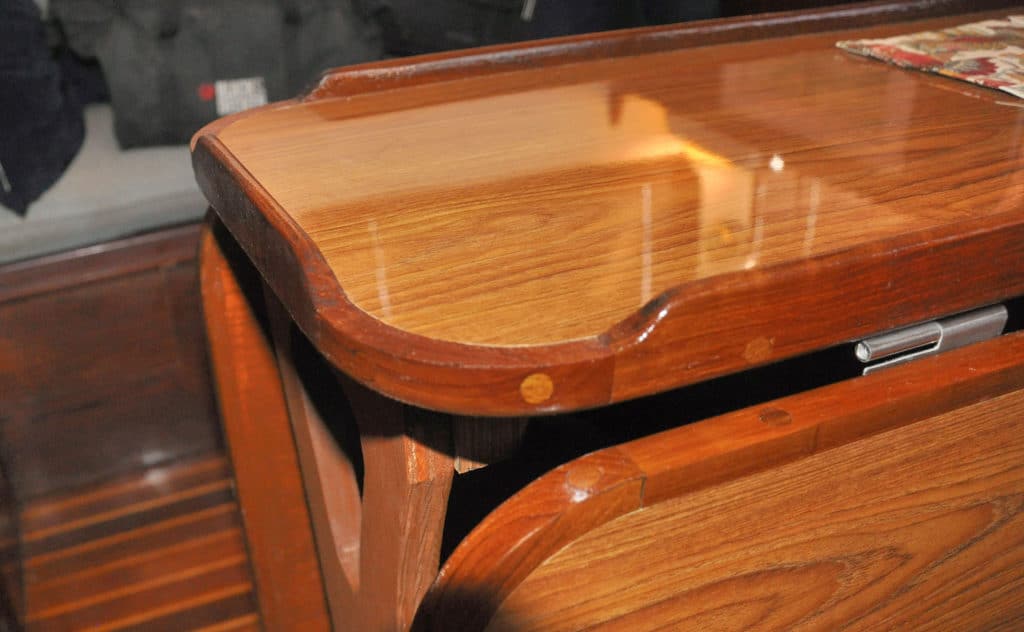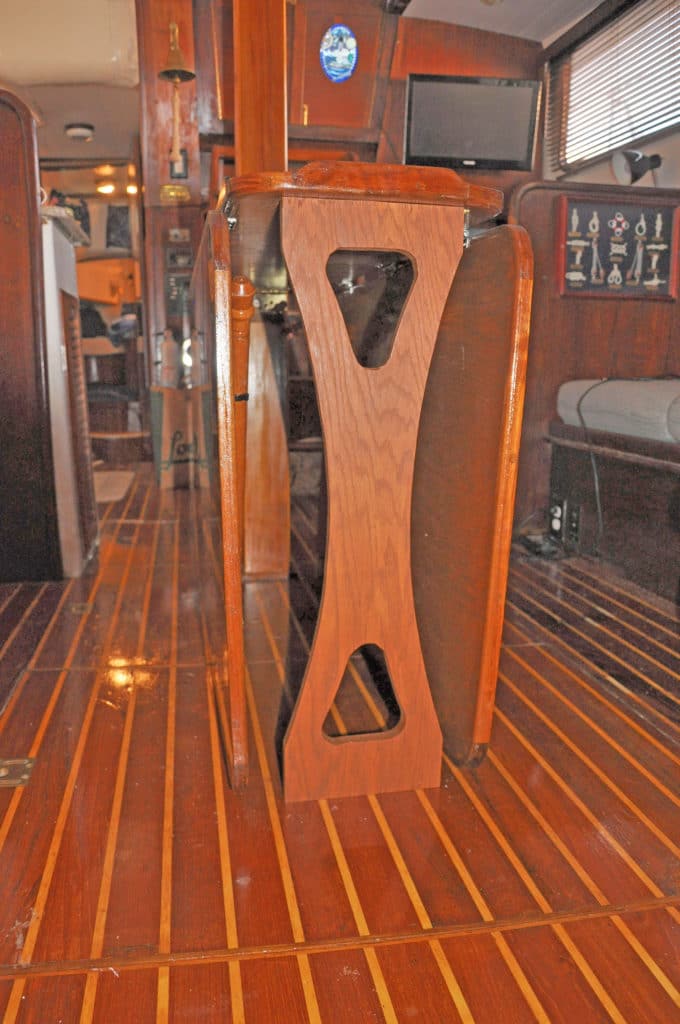
The original saloon table on my Down East 45 schooner was a single heavy sheet of 3⁄4-inch-thick laminated plywood, 27 inches wide by 57 inches long. It was supported on two substantial aluminum pedestals locking into large, round collars screwed to the floor and table.
There were two annoying problems with this structure: It was permanently mounted on the port side of the saloon, so people sitting on the starboard settee couldn’t reach the table. It was also difficult to squeeze in and out of one end because the chart table bulkhead was in the way. It was a very large but also impractical table, so I decided to build myself a more versatile one that could seat more than just three people.
My new design would have a narrow, fixed center section, with hinged leaves on either side that swing up to reach either or both of the settees. This is hardly a unique concept, so why didn’t the original builders do it this way? To make it the right height for the settees, the table needed to be 27 inches high, but this meant the new leaves could not be more than 27 inches or they would catch on the floor when they were down. With both leaves open, this left a 13-inch space in the middle, which determined the width of the fixed section. The table would be 43 inches long to allow access on all sides.
Tabletop

I started with a 4-by-8-foot sheet of oak plywood from Lowe’s. The folks at the store cut this large, heavy sheet to my three panel sizes on their circular saw, which saved me a lot of time and enabled me to fit the pieces into my vehicle. I wanted rounded corners on all the pieces, so I traced around a tin lid to give me a radius, then cut the corners with a fine scrolling blade fitted in my jigsaw.
I decided to laminate the tabletops with a high-pressure melamine laminate, similar to Formica, because it is both hard and scratch-resistant. I found exactly what I was looking for on the Wilsonart website. It is a realistic-looking teak-grained laminate called Nepal Teak in a high-gloss finish that looks just like real varnished teak. I special-ordered a 4-by-8-foot sheet from Lowe’s. It is 3⁄64 inch thick, and I cut it to the approximate size of each table section using metal cutting shears, leaving about a 1⁄2-inch overhang on all sides. Then I glued them on the plywood using, Weldwood’s original contact cement, which is more liquid than the gel variety. I spread it on the plywood and laminate surfaces with a 6-inch roller, then waited for the glue to become tacky. When joining large surfaces of laminate with contact cement, you have to get it right on the first try because the cement bonds on contact and there is no wiggle room. I placed the laminate on my workbench with the glue side up, then laid two thin wooden battens on each end. I put the plywood on top, glue side down. The wood strips kept the two pieces apart while I positioned the plywood accurately above the laminate. It was then a simple matter to slide the battens out and press the plywood to the laminate. I then placed the board on some paper on the house floor and walked all over it in my deck shoes. This applied much more than the 75 pounds of pressure called for in the gluing instructions and firmly pressed the pieces together.
After leaving the three boards overnight for the glue to harden, I carefully trimmed the laminate flush with the edges of the boards, using a router with a vertical cutting bit and roller-bearing guide. This produced a sharp, straight edge to which I intended to fit teak trim all the way around.
Trim

I had some 1⁄2-inch-thick teak slats left over from a forward-cabin rebuild that were just right to make the straight-edge trim for the panels. Of course, this was much too thick to bend around the corners, so I used my jigsaw to cut rounded trim from bits of solid teak I had saved from previous projects. All the trim had to be drilled and counterbored, then screwed and glued to the edges of the three boards. Then all the holes — 75 total — had to be plugged and sanded.
I decided to make fixed fiddles on the center section because the things that invariably get placed there are liable to slide off when the boat rocks — even in a marina. I cut strips to length and beveled and rounded the tops, then shaped both ends in a graceful swan’s-neck curve to join the corner trim. I left the corners open to enable the table to be wiped, and to add a bit of decorative accent.
An unusual stumbling block I didn’t anticipate was keeping track of all the pieces of trim that had been shaped to match the individual edges and corners. I made 12 corner pieces, four edging strips for fiddles and eight other edging trims. All were slightly different, because this table was nothing if not “handcrafted.”
I hinged the table’s leaves using six stainless-steel sliding pull-apart hinges — three on each leaf. These allow the leaves to be easily detached from the center section when necessary, such as to access the floorboards.
Supports

The mainmast compression post on my schooner is a 4-inch square post passing through the saloon to the keelson, and it offered a perfect support for one end of the table’s center section. I used a 4-inch brass-plated butt hinge to support that end of the table, screwing one half of the hinge to the compression post with a teak block spacer and the other to the underside of the table. The spacer is important because it enables the center section of the table to hinge up and hang with a strop to a deck beam when I need access to the floorboards. This attachment method also allows me to remove the table completely by simply knocking the hinge pin out, separating the two halves of the hinge.
To support the other end of the table, I shaped a leg out of plywood. I attached it at the top with a short piano hinge that allows the leg to fold flat to the underside of the center section of the table whenever it’s lifted to get to the floorboards. I secured the bottom of the leg with two pins that drop into flanged bushings I set in the floor. I made the pins by screwing 1⁄4-inch-diameter stainless wood screws into the bottom of the support, then hack-sawing the heads off and rounding them with a file. To support the table’s leaves, I bought two attractive turned-wood table legs, grandly termed “early American table legs,” from Lowe’s. I fastened the top of each leg to the center of the leaf edge’s underside, using a small brass hinge, so when not in use, each leg folds to the inside of the leaf, where it is held by a plastic C-clip. I screwed 1⁄4-inch-diameter pins in the bottom of each leg, which drop into bronze flange bushings I sunk into the floor. This simple yet secure support for the table leaves is much stronger than center-section supports like those I have had on other boats, which nearly always allow the leaves to sag. I also bought two brass barrel-bolt latches, which I screwed to each leaf. The bolts drop into flanged bushings set in the floor and stop the leaves from swinging about in the folded-down position when the boat heels.
I stained the plywood on the underside of the panels and the table legs with teak stain, which, when rubbed with a rag, made the wood look amazingly like the shade of real teak. I bought a quart of the stain, called 120 Teak Natural and made by Zar, from a local hardware store. When all the woodwork was complete, I varnished it with two coats of Epifanes high-gloss wood varnish. The result is that it’s difficult to distinguish between the real teak trim and the laminate.
When both leaves are extended, the new table is more than twice the size of the old one and looks positively baronial. More important, it is much more functional because it easily seats six and allows access all around, yet when the leaves are down it is smaller than the original.
Roger Hughes is nearing the completion of a six-year project restoring his Down East 45, Britannia. For more on the restoration, visit his website www.schooner-britannia.com.








